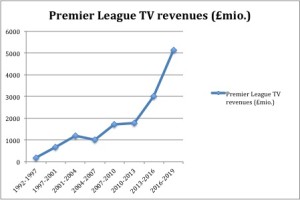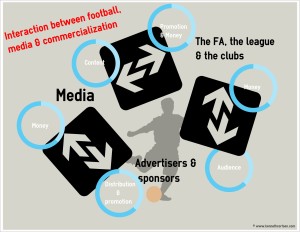The English Premier League’s new TV rights 3-year deal from the 2016-2017 season shows a huge increase compared to BT and Sky’s current deal. The current deal has a value of approximately £3 billion while the new deal of approximately £5.1 billion symbolizes a 70 % increase. Thus, it will be interesting to see how the new #Premier League deal will affect the price of elements like TV production costs, TV packages, ticket prices and players’ wages.
From my point of view, this is a chance for the Premier League to accommodate the challenges of extremely high ticket prices so that fans are recognized as the driving force of the football economy and so that the average attendance level of the Premier League may be boosted to get closer to the level of the German Bundesliga. Specifically, I hold the view that whether focus is on the league or the club level, it should be emphasized that strong revenue generation and/or profitability should lead to a proportional allocation of resources towards factors that help raise the sustainability profile of football’s business models, i.e. towards grassroots development, infrastructure and fan-related priorities. The latter is already a heated debate topic among football enthusiasts from all levels of the English society given the fact that many people believe that the ‘true football lovers and hence football fans’ that invest highly in football in terms of time derived from team support must also be able to benefit from this gigantic deal in alignment with the grassroots level. Therefore, it will be exciting to see where this ends.
Figure 1: The rapid growth rates of the Premier League’s TV income (source: own making).
However, it is vital to note that the Premier League already reserves funds for this stuff but unfortunately the overall football economy at the league and club level has not always accommodated this central focus point. But the crux of the matter and the paradox in this discussion is how or if the Premier League will utilize this capital injection to meet fans at eye level. This perception should be interpreted in the sense that the inflation regarding Premier League ticket prices does not match the expectations of the fans and give them the priority deserved as football is THE game of the masses in terms of participation level and popularity and when all comes to all the enormous fan appeal gives football its passionate texture and the emotional equity capable of moving eyeballs and securing revenue generation.
Figure 2: Interaction between football, media and commercialization (source: own making).
Strategically, the FA, the Premier League and the clubs should collaborate to emphasize the objective of offering a great football product to full stadiums and to TV audiences worldwide. In doing so, there is also an obligation to cater to families and thus young fans to generate ‘fans for life’. As shown in figure 2, the Premier League offers fantastic football content to BT Sport and Sky Sports so this football product also leverages a large global football audience that can be targeted by advertisers and (live match) sponsors. This explains part of football’s business model. What is not included in figure 2 is the fact that the sustainability of football’s business model may be underscored by football fans’ high demand for media subscriptions that portray football all sides of the football product. And the Premier League has built its brand around top quality players from all regions of the world and this new deal will help to spark the strength and popularity of the English Premier League and gives clubs a good opportunity to grow their business.
| The construction of the TV deal | |
| BT Sport | 36 matches on Saturday, including 28 at 5.30pm
6 midweek evening matches |
| Sky Sports | 28 Saturday at 12.30pm
28 Sunday 1.30pm-2.15pm 28 from 16:00-16:30 on Sunday 28 Monday (no less than 18) or Friday (no more than 10) Eight Bank Holiday and 6 Sunday |
Figure 3: The construction of the TV deal (source: own making).


COMMENTS
No comments yet.